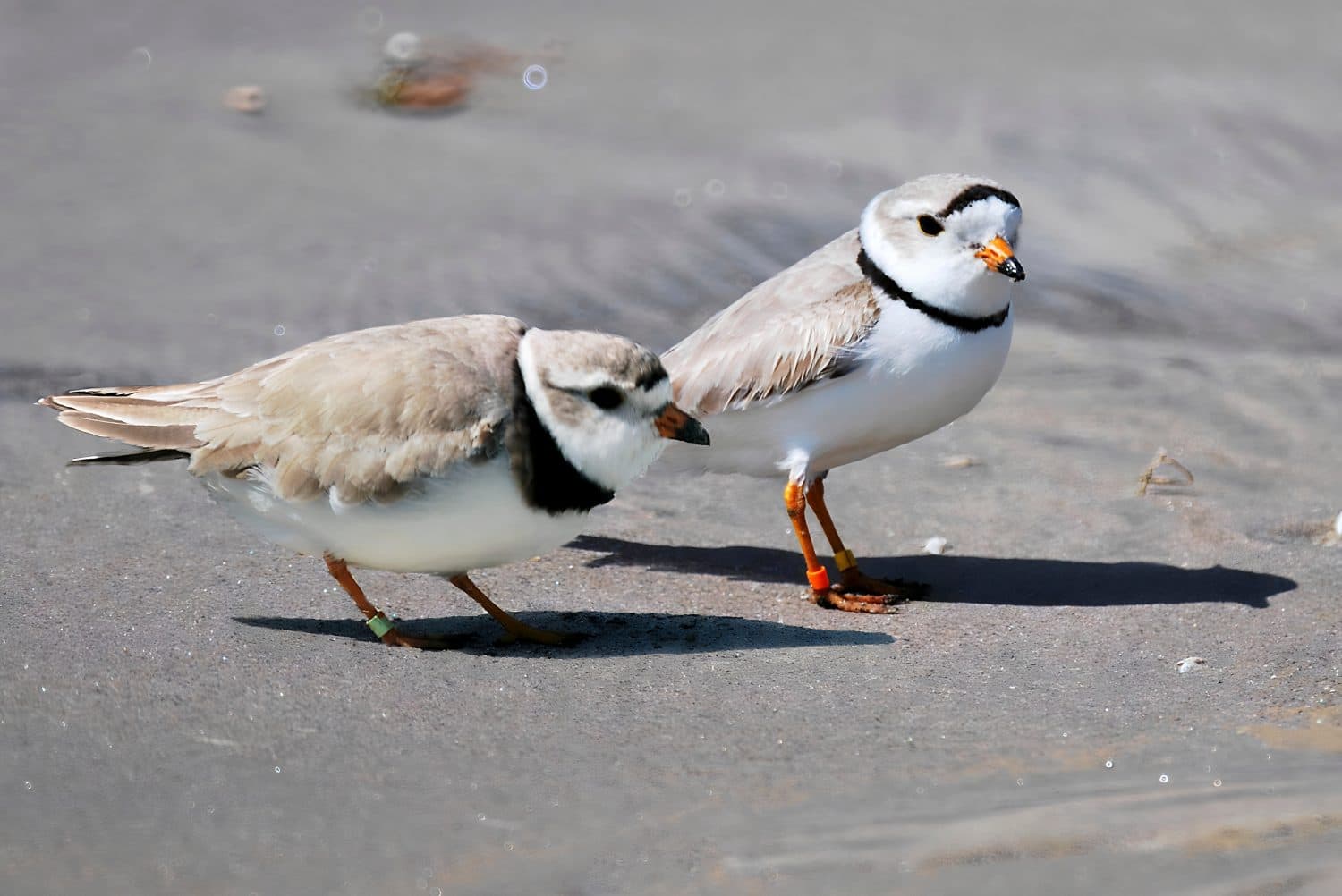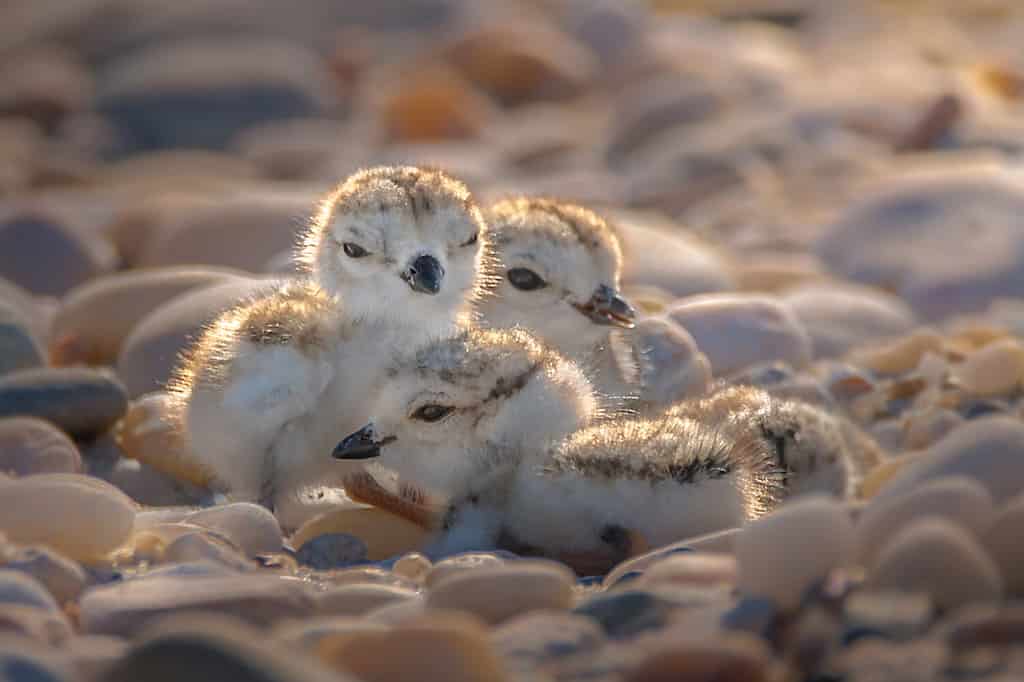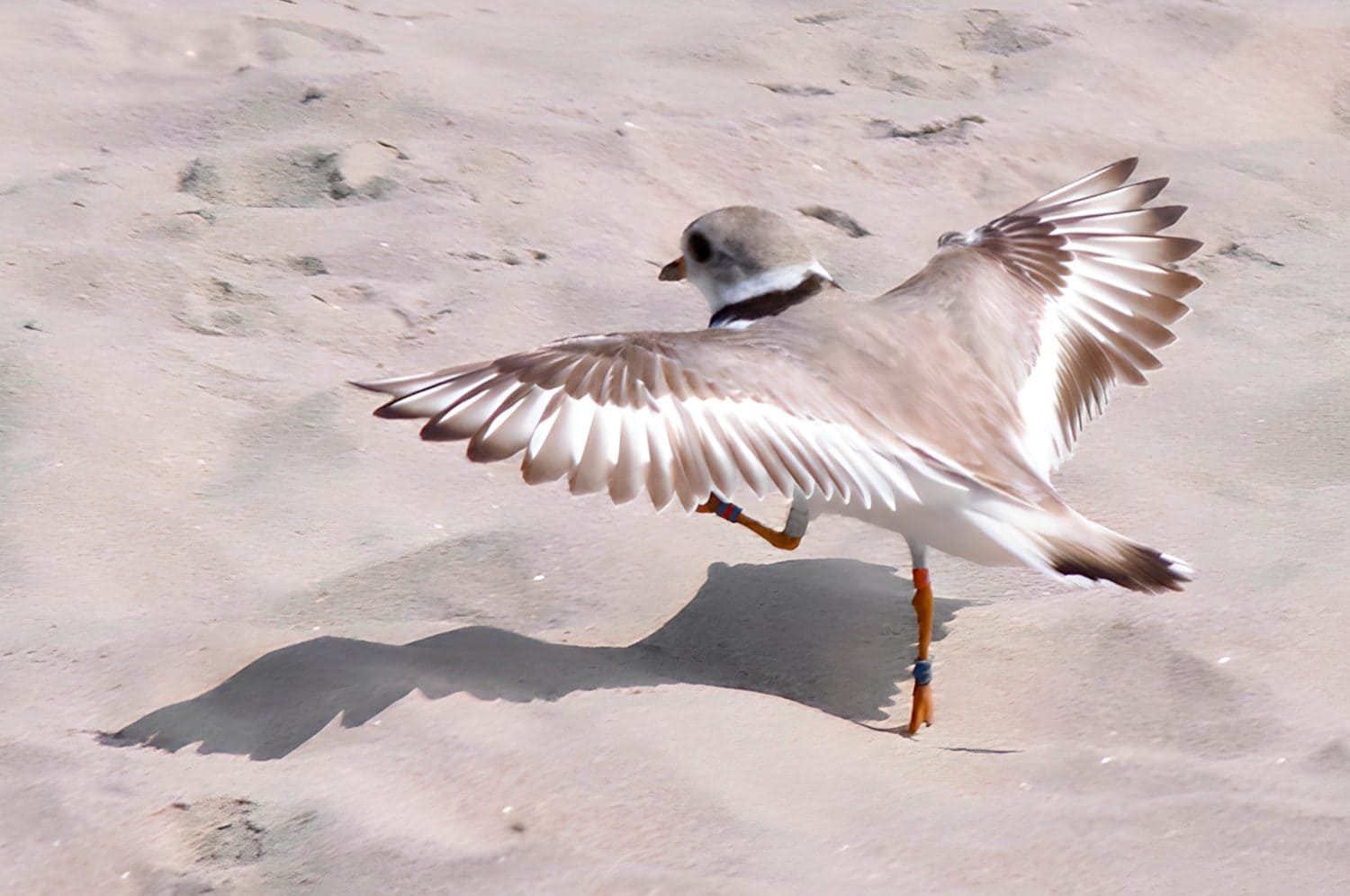The Piping Plover, Charadrius melodus, lives in North America. It exists primarily in three distinct breeding populations. The U.S. Fish and Wildlife Service lists two populations as threatened, and the third as endangered. This struggling shorebird has an estimated population of fewer than 8,400 mature adults. These uncommon little birds blend in very well in their habitat. You may find yourself enchanted if you happen to spot a Piping Plover in the wild. Read on to learn all about this amazing species.
Scientific Background of the Bird

Two different subspecies of Piping Plovers exist, occurring in three separate populations.
©Susana Miranda/Shutterstock.com
The American zoologist, George Ord, Jr., first described the Piping Plover in 1824. It was classified as part of the Charadrius genus of plovers. Scientists split the genus in 2023, based on genetic findings, moving many of the birds including the Snowy Plover to the Anarhynchus genus. The Piping Plover, along with the Killdeer and nine other closely related species, remain in the Charadrius genus.
The Piping Plover is so named because of its melodic call that sounds like a bell or pipe. Its scientific name Charadrius melodus, also gives reference to its ear-pleasing call.
Scientists have identified two subspecies of Piping Plovers. The nominate subspecies, Charadrius melodus melodus, lives and breeds along the Atlantic Coast. The other subspecies, C. melodus circumcinctus, exists in two separate populations. The larger population lives in the Northern Great Plains region. Its breeding range extends from Colorado and Nebraska in the United States, north to Alberta, Canada.
Appearance

Piping Plovers are small, round shorebirds the color of sand, with short bills and yellow-orange legs.
©Bouke Atema/Shutterstock.com
The Piping Plover is a small, oval-shaped bird roughly the same size as a House Sparrow. It has a rounded body and head with a short neck and a short tail. It has a short, pointed, orange bill with a black tip. The large, dark, round eyes of this bird contribute to its cuteness factor.
Adults of the species have bright yellowish orange legs and feet. Their legs are shorter than those of many shorebirds, but longer than the average songbird. Piping Plovers reach lengths of only about 5.9 to 7.5 inches. They have a wingspan that averages about 15 inches.
The Piping Plover may virtually disappear against the sand due to its discreet plumage. It has feathers the color of sand on its upper body, with white on its undersides. In breeding season, the male of the species has prominent black markings on its forehead and around the neck. The black collar fades in the off season. The female has a similar band on her forehead, but it appears lighter than that of the male.
Where Do Piping Plovers Live?

The Piping Plover lives along shorelines on the coast or along inland lakes and rivers.
©Randy G. Lubischer/Shutterstock.com
The nominate subspecies of the Piping Plover, C. m. melodus, lives along the Atlantic Coast, from far southeastern Canada all the way to the Gulf of Mexico. The other subspecies, C. m. circumcinctus, lives in two separate populations. One of these populations occurs on a small section of the shores of the Great Lakes. The other lives along rivers and lakes in the wetlands of the Northern Great Plains region, stretching from Alberta, Canada to Colorado and Nebraska in the south.
In the winter, Piping Plovers migrate south. Some end up along the Gulf of Mexico, and others travel to parts of the Caribbean or even the northern shores of South America. Along the way, these birds make use of wetlands, shorelines, and mud flats. This species migrates south from August through September, and they make their return to the north around the beginning of spring.
Where Do They Nest?
Piping Plovers stick to the shorelines around the coast or inland bodies of water. They build their nests up and away from the water line, near clumps of grass or vegetation. A casual observer might not even recognize a Piping Plover nest. These birds simply make a small scrape in the ground, about half an inch deep and just a few inches long. Each pair will make several scrapes before deciding which one will become their nest. Once they have decided, they may line the nest with small materials, such as pebbles or bits of shells, before laying their eggs.
Reproduction

Piping Plovers usually have one clutch per year with an average of four eggs.
©Jay Gao/Shutterstock.com
Male Piping Plovers arrive in their breeding area in the middle of March. They begin establishing their territory and matching with females to form monogamous pairs by the late part of the month. Once a pair has formed, the male will begin making scrapes as potential nest sites. The female chooses from among the scrapes and the male begins a mating ritual that may consist of stomping the ground and flying in prescribed patterns. If the female finds the male’s advances to her approval, mating follows shortly thereafter.
Piping Plovers usually lay four eggs in each clutch. The female lays one egg every other day until she completes the clutch. Incubation begins after the female lays the final egg of the clutch. It takes an average of 27 days. Both the male and the female share responsibility for incubating the eggs. Although the female lays her eggs in sequence, they all hatch on the same day. The precocial chicks can walk about within hours after they hatch, but they will stay close to the nest for about the first 30 days of their lives.
The parents may share the work of watching over their hatchlings until they fledge. Or the female may leave the offspring in the care of the male while she starts a new clutch. Most pairs only form one clutch per year, but sometimes they form more than one. The loss of the first clutch, or a ratio skewed too highly toward male offspring may influence the female to try again. Most double clutches result from monogamous pairs, but rarely, researchers have noted female Piping Plovers mating with a different male in the same season.
Behavior

Piping Plovers can fly well, but they spend most of their time on the ground.
©Susana Miranda/Shutterstock.com
Piping Plovers tend to share shorelines with other birds, including those of their own species, as well as others such as Least Terns. They may nest relatively close to another pair, but do not tend to engage in colonial nesting. Individuals typically stick close to their mate or family unit during breeding season. Males will engage in aggressive displays to keep others out of their territory during breeding season. However, once that season ends, these birds will form flocks of up to 100 birds during migration with little hostile interaction.
Although their little, round bodies may not give much indication, Piping Plovers fly quite well. After all, they migrate long distances in the fall and the spring. But once they reach their destination, they spend most of their time on the ground, often foraging for food. These clever birds engage in a curious behavior wherein they use one foot to patter on the ground, possibly to draw prey to the surface.
Diet
Piping Plovers search for prey close to the edge of the water. They run along the sand, stopping to look around for prey such as different types of worms, insects such as beetles and flies, larvae, crustaceans, and other invertebrates. They use their sharp bills to peck in the sand and retrieve prey from below the surface.
Are Piping Plovers Rare?
Piping Plovers are considered rare. The U.S. Fish and Wildlife Service listed the population around the Great Lakes as endangered. The other two populations, on the Atlantic Coast and in the Northern Great Plains region, are listed as threatened. The total population of the species, based on most recent estimates, numbers around 8,400 mature individuals or fewer.
Scientists have made many conservation efforts to try to preserve the species. Some include limiting access to Piping Plover critical habitat and providing protective exclosures to keep predators out of existing nests. Still, one of the greatest threats to the Piping Plover is habitat degradation due largely to climate change. This threat impacts not only this species, but many others that rely on shorelines for breeding and habitat.
The photo featured at the top of this post is © iStock.com/BrianEKushner
Thank you for reading! Have some feedback for us? Contact the AZ Animals editorial team.







